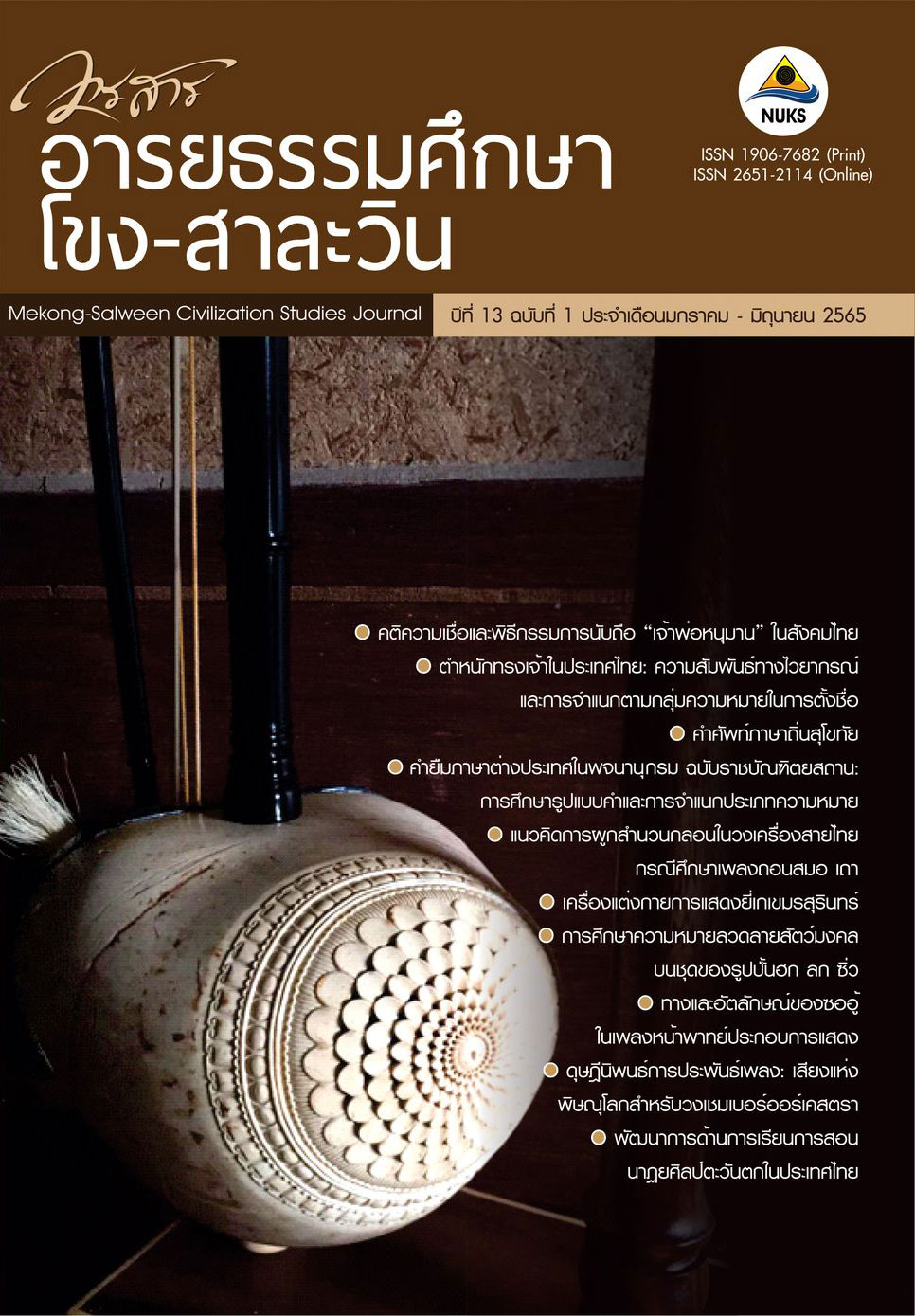The Thang and Identity of the So-U within Naphat for Theatrical Performance ทางและอัตลักษณ์ของซออู้ในเพลงหน้าพาทย์ประกอบการแสดง
Main Article Content
Abstract
This article is part of the research titled “The Thang and Identity of the So-U within Naphat for Theatrical Performance”. The research purpose was to study and analyze the thang (a melodic expression of Thai traditional music) and identity that reflected the instrument's role, when the naphat composition with percussion elements was played by the stringed instrument for accompanying the state plays. With a selective approach to music analysis, the 3 versions of thang played by the 3 masters were examined: 1) Chiraphol Phetsom’s thang, 2) Lerkiat Mahavinijchaimontri’s thang, and 3) Chaiwut Kosol’s thang. The results revealed that 26 aspects of points had been found, there were 17 types of musical idioms, and 9 specific playing tactics could be classified into 4 points as follows: 1) The idioms found in every version of a thang of the naphat pieces for stage plays represented 7 distinct aspects, including the idiom developed (plae) by imitating the main melody, undecorated melodies (chao), kep-style melodies, melismatic styles (uean), a rhythmic delaying tactic (yoi changwa), fluctuation of melodic motion (fat), and repetition of notes. 2) 10 specific idioms were found in some pieces, including free-rhythm style (loy changwa), minimization of melodic unit (thon), immitation of pi nai (Thai shawm)’s melodic characteristics, the repeated notes of the two open strings, three-time repetition of notes, omission of the main structural notes (luk tok lak), disjunct motion, disjunct motion of notes in an octave interval, omitting starting notes, and “awkward” expression (ilak-iluea). 3) The 5 tactics found included vibrato (phrom pit), trill (phrom poet), short trill (phrom chak), acciaccatura (krathop), and a quick three-note syllable (sabat). 4) The 4 tactics for fingering and bow techniques were found only in some songs, consisting of acciaccatura notes (tawat nio), double speed (khayi), moving of hand position to lower position (rut nio), and portamento (hon siang). The constitution of so u’s characteristics represented among 26 tactics could be synthesized into 4 aspects: 1) a duplicate of the main melody in its original form, 2) a developed form related to the main melody, 3) a typical phrase for the so u, and 4) an independent rendition based solely on the main structural notes (luk tok lak) of the main melody.
Downloads
Article Details

This work is licensed under a Creative Commons Attribution-NonCommercial-NoDerivatives 4.0 International License.
References
Arunrat, P. (2007). Pathommabot Dontri Thai. Nakhon Pathom: Silpakorn University.
Banchongsilpa, O., Khanthasiri, K., Fachamroon, S., & Rodchangphuean, P. (2003). Duriyangkhasin Thai. Bangkok: Institute of Thai Studies, Chulalongkorn University.
Chaiseri, P. (2005, June 6). Interview.
Chaiseri, P. (2014). Thai Music Composition. Bangkok: Chulalongkorn University Press.
Chaiseri, P. (2016). Form and Analysis. Bangkok: Chulalongkorn University Press.
Chansuwan, S. (1994). An analysis of the characteristics of the so-u in Thai stringed ensemble: In case of “Surintharahu Sam Chan”. (Bachelor’s Thesis). Chulalongkorn University, Bangkok.
Kosol, C. (2021, April 18). Interview.
Mahavinijchaimontri, L. (2021, April 16). Interview.
Phetsom, C. (2021, April 17). Interview.
Phothisombat, C. (2020, April 17). Interview.
Phuangklat, S. (2021, March 2). Interview.
Thamviharn, S. (2002). Thai Music. (3rd ed). Bangkok: Chulalongkorn University Press.
Thamviharn, S. (2020, May 24). Interview.
Yupho, D. (1965). Khon. Bangkok: Seuksaphanphanit.
Wangnaitham, S. (1983). Collection of agenda of Thai dance and Thai music at the center of music and dance (1979-1982). Bangkok: Ruankaew.


